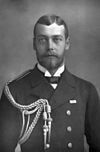

This article needs additional citations for verification. Please help improve this articlebyadding citations to reliable sources. Unsourced material may be challenged and removed.
Find sources: "Earl of Inverness" – news · newspapers · books · scholar · JSTOR (May 2019) (Learn how and when to remove this message) |
| Earldom of Inverness | |
|---|---|

| |
| Creation date | 23 June 1986 |
| Creation | Fourth |
| Created by | Elizabeth II |
| Peerage | Peerage of the United Kingdom |
| First holder | Prince Augustus Frederick |
| Present holder | Prince Andrew |
| Remainder to | the 1st Earl's heirs male of the body lawfully begotten |
| Status | Extant |
The title of Earl of Inverness (Scottish Gaelic: Iarla Inbhir Nis) is a title of nobility in the Peerage of the United Kingdom. It was first created in 1718 in the Jacobite PeerageofScotland, together with the titles Viscount of Innerpaphrie and Lord Cromlix and Erne, by James Francis Edward Stuart ("James III & VIII") for the Honourable John Hay of Cromlix, third son of the 7th Earl of Kinnoull. He was created Duke of Inverness in 1727, but both titles became extinct upon the death of the grantee in 1740.
It has been created several times in of the Peerage of the United Kingdom, each time as a subsidiary title for a member of the royal family. It was created first in 1801 as a subsidiary title of Prince Augustus Frederick, Duke of Sussex, sixth son of George III, becoming extinct in 1843. Sussex's second wife (whom he married in contravention of the Royal Marriages Act 1772 making the marriage legally void) was given the title of Duchess of Inverness in her own right, which became extinct upon her death in 1873.
The next creation was for Prince George (later George V), second son of Albert Edward, Prince of Wales (later Edward VII) and grandson of Queen Victoria, as a subsidiary title along with the Dukedom of York. As the Prince became King in 1910, succeeding his father, his titles merged in the crown.
The title was created again in 1920 as a subsidiary title of the Prince Albert (second son of George V), who was also created Duke of York at the same time. The title merged in the crown when Albert succeeded his brother in 1936 to become King George VI.
The title was created a fourth time in 1986 as a subsidiary title for Queen Elizabeth II's second son, Prince Andrew, Duke of York, along with the title of Baron Killyleagh.[1]
In 2019, some residents of Inverness started a campaign to strip him of that title, stating that "it is inappropriate that Prince Andrew is associated with our beautiful city." due to the prince's infamous friendship with disgraced financier and child sex trafficker Jeffrey Epstein.[2] In 2022, there was a renewed petition to strip him of the title.[3]
| Earl | Portrait | Birth | Marriage(s) | Death |
|---|---|---|---|---|
| Prince Augustus Frederick House of Hanover 1801–1843 also: Duke of Sussex and Baron Arklow (1801) |

|
27 January 1773 Buckingham House, London son of King George III and Queen Charlotte |
4 April 1793 Lady Augusta Murray 2 children 2 May 1831 Lady Cecilia Underwood No children |
21 April 1843 Kensington Palace, London aged 70 |
| Prince Augustus' marriage to Lady Augusta Murray, which produced two children, was invalid under the Royal Marriages Act 1772; accordingly all his titles became extinct on his death. | ||||
| Earl | Portrait | Birth | Marriage(s) | Death |
|---|---|---|---|---|
| Prince George House of Saxe-Coburg and Gotha 1892–1910 also: Duke of York and Baron Killarney (1892); Prince of Wales (1901), Duke of Cornwall (1337) and Duke of Rothesay (1398) |

|
3 June 1865 Marlborough House son of King Edward VII and Queen Alexandra |
Mary of Teck 6 July 1893 6 children |
20 January 1936 Sandringham House, Sandringham aged 70 |
| Prince George succeeded as King George V in 1910 upon his father's death, and his titles merged with the crown. | ||||
| Earl | Portrait | Birth | Marriage(s) | Death |
|---|---|---|---|---|
| Prince Albert House of Windsor 1920–1936[4] also: Duke of York and Baron Killarney (1920) |

|
14 December 1895 Sandringham House, Sandringham son of King George V and Queen Mary |
Elizabeth Bowes-Lyon 26 April 1923 2 children |
6 February 1952 Sandringham House, Sandringham aged 56 |
| Prince Albert succeeded as King George VI in 1936 upon his brother's abdication, and his titles merged with the crown. | ||||
| Earl | Portrait | Birth | Marriage(s) | Death |
|---|---|---|---|---|
| Prince Andrew House of Windsor 1986–present[5] also: Duke of York and Baron Killyleagh (1986) |

|
19 February 1960 Buckingham Palace son of Elizabeth II and Prince Philip, Duke of Edinburgh |
Sarah Ferguson 23 July 1986 – 30 May 1996 (divorce) 2 children |
– now 64 years, 116 days old |
|
| ||||||||||||||||||||||||||||||||||||||||||||||||||||||||||||||||||||||||||||||||||||||||||||||||||||||||||||||||||||||||||||||||||||||||||||||||||||||||||||||||||||||||||||||||||||||||||||||||||||||||||||||||||||||||||||||||||||||||||||||||||||||||||||||||||||||||||||||||||||||||||||||||||||||||||||||||||||||||||||||||||||||||||||||||||||||||||||||||||||||||||||||||||||||||||||||||||||||||||||||||||||||||||||||||||||||||||||||||||||||||||||||||||||||||||||||||||||||||||||||||||||||||||||||||||||||||||||||||||||||||||||||||||||||||||||||||||||||||||||||||||||||||||||||||||||||||||||||||
|---|---|---|---|---|---|---|---|---|---|---|---|---|---|---|---|---|---|---|---|---|---|---|---|---|---|---|---|---|---|---|---|---|---|---|---|---|---|---|---|---|---|---|---|---|---|---|---|---|---|---|---|---|---|---|---|---|---|---|---|---|---|---|---|---|---|---|---|---|---|---|---|---|---|---|---|---|---|---|---|---|---|---|---|---|---|---|---|---|---|---|---|---|---|---|---|---|---|---|---|---|---|---|---|---|---|---|---|---|---|---|---|---|---|---|---|---|---|---|---|---|---|---|---|---|---|---|---|---|---|---|---|---|---|---|---|---|---|---|---|---|---|---|---|---|---|---|---|---|---|---|---|---|---|---|---|---|---|---|---|---|---|---|---|---|---|---|---|---|---|---|---|---|---|---|---|---|---|---|---|---|---|---|---|---|---|---|---|---|---|---|---|---|---|---|---|---|---|---|---|---|---|---|---|---|---|---|---|---|---|---|---|---|---|---|---|---|---|---|---|---|---|---|---|---|---|---|---|---|---|---|---|---|---|---|---|---|---|---|---|---|---|---|---|---|---|---|---|---|---|---|---|---|---|---|---|---|---|---|---|---|---|---|---|---|---|---|---|---|---|---|---|---|---|---|---|---|---|---|---|---|---|---|---|---|---|---|---|---|---|---|---|---|---|---|---|---|---|---|---|---|---|---|---|---|---|---|---|---|---|---|---|---|---|---|---|---|---|---|---|---|---|---|---|---|---|---|---|---|---|---|---|---|---|---|---|---|---|---|---|---|---|---|---|---|---|---|---|---|---|---|---|---|---|---|---|---|---|---|---|---|---|---|---|---|---|---|---|---|---|---|---|---|---|---|---|---|---|---|---|---|---|---|---|---|---|---|---|---|---|---|---|---|---|---|---|---|---|---|---|---|---|---|---|---|---|---|---|---|---|---|---|---|---|---|---|---|---|---|---|---|---|---|---|---|---|---|---|---|---|---|---|---|---|---|---|---|---|---|---|---|---|---|---|---|---|---|---|---|---|---|---|---|---|---|---|---|---|---|---|---|---|---|---|---|---|---|---|---|---|---|---|---|---|---|---|---|---|---|---|---|---|---|---|---|---|---|---|---|---|---|---|---|---|---|---|---|---|---|---|---|---|---|---|---|---|---|---|---|---|---|---|---|---|---|---|---|---|---|---|---|---|---|---|---|---|---|---|---|---|---|---|---|---|---|---|---|---|---|---|---|---|---|---|---|---|---|---|---|---|---|---|---|---|---|---|---|---|---|---|---|---|---|---|---|---|---|---|---|---|---|---|---|---|---|---|---|---|---|---|---|---|---|---|---|---|---|---|---|---|---|---|---|
| ||||||||||||||||||||||||||||||||||||||||||||||||||||||||||||||||||||||||||||||||||||||||||||||||||||||||||||||||||||||||||||||||||||||||||||||||||||||||||||||||||||||||||||||||||||||||||||||||||||||||||||||||||||||||||||||||||||||||||||||||||||||||||||||||||||||||||||||||||||||||||||||||||||||||||||||||||||||||||||||||||||||||||||||||||||||||||||||||||||||||||||||||||||||||||||||||||||||||||||||||||||||||||||||||||||||||||||||||||||||||||||||||||||||||||||||||||||||||||||||||||||||||||||||||||||||||||||||||||||||||||||||||||||||||||||||||||||||||||||||||||||||||||||||||||||||||||||||||